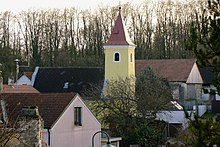Putzing (community Großebersdorf)
|
Putzing ( village ) locality cadastral community Putzing |
||
|---|---|---|
|
|
||
| Basic data | ||
| Pole. District , state | Mistelbach (MI), Lower Austria | |
| Judicial district | Mistelbach | |
| Pole. local community | Großebersdorf | |
| Coordinates | 48 ° 22 '13 " N , 16 ° 27' 4" E | |
| height | 210 m above sea level A. | |
| Residents of the village | 455 (January 1, 2020) | |
| Building status | 273 (2001) | |
| Area d. KG | 3.63 km² | |
| Statistical identification | ||
| Locality code | 05040 | |
| Cadastral parish number | 15214 | |
| Counting district / district | Putzing (31614 002) | |
| Source: STAT : index of places ; BEV : GEONAM ; NÖGIS | ||
Putzing is a cadastral community, belongs to the community of Großebersdorf and has a little over 550 inhabitants. The place is in the Mistelbach district in Lower Austria .
geography
Putzing is located six kilometers north of the city limits of Vienna , between Großebersdorf and Manhartsbrunn . Putzing is north of the Wartberg, 242 m above sea level. A. in the transition zone from Marchfeld to Weinviertel . To the south of the Wartberg is the Putzing am See weekend house settlement around a swimming lake .
history
The year the town was founded is not known. However, there was a noble family that named themselves "de Puzingen" after the place. Thus at least one permanent house should have existed in which this sex had its ancestral seat. At that time the lordship was at Wolkersdorf , but the places Ulrichskirchen , Bisamberg , Korneuburg , as well as the Stammersdorf monastery , the Minorites in Vienna and the Großebersdorf church also had property or rights in Putzing. There are no direct sources, but it can be assumed that Putzing also suffered from destruction from the war in Sweden (1645) and the second Turkish siege of Vienna (1683). This can be concluded from the better sources of the neighboring towns of Großebersdorf and Enzersfeld.
Various field names as upper, middle and lower panels are reminders of the time the three-field system .
Second World War
In the last days of World War II , Putzing was the scene of war crimes . There is a detailed report on this in the archive of the Army History Museum . Accordingly, the residents fled into the wine cellars several days before the Red Army arrived . Putzing was set up for defense by several smaller units of the Wehrmacht and the Waffen SS . However, given the obvious superiority of the Russians, the place was evacuated without a fight. On April 13, 1945, Russian soldiers marched into Putzing, the residents initially did not believe the rumors about the atrocities of the Red Army and wanted to welcome the Russian soldiers with “wine and good food” as “liberators”. “You were bitterly disappointed. The soldiers rushed like wild animals on the quantities of wine stored in the cellars and then, in an intoxicated state, on women and girls in an almost cattle-like manner. The men were chased out of the cellars with buttocks and were unable to protect the women. These monsters did not shy away from old women and stronger children. ”The torture by Russian soldiers may have lasted for days, the report goes on to say:“ May 1st was a big holiday [...], this one The night was especially desolate. ”Two men who wanted to protect their wives were shot, another man and a woman were shot.
Population development
According to the results of the 1934 census , there were 335 inhabitants. Today there are about 500 inhabitants.
Institutions
There is a volunteer fire brigade Putzing, the village renewal association Putzing and there is a health psychological ordination. There is also a branch church of the Großebersdorf parish .
Individual evidence
- ^ Army History Museum / Military History Institute (HGM / MHI) , Military History Research Department (MilFoA), study collection, inventory 1945, box 5, fasc. 45/9, municipality reports Lower Austria, District Mistelbach
- ↑ Putzing village renewal association. Retrieved June 11, 2019 (Austrian German).
Web links
- Putzing on the website of the community Großebersdorf
- Voluntary fire brigade Putzing ( Memento from June 11, 2010 in the Internet Archive )


